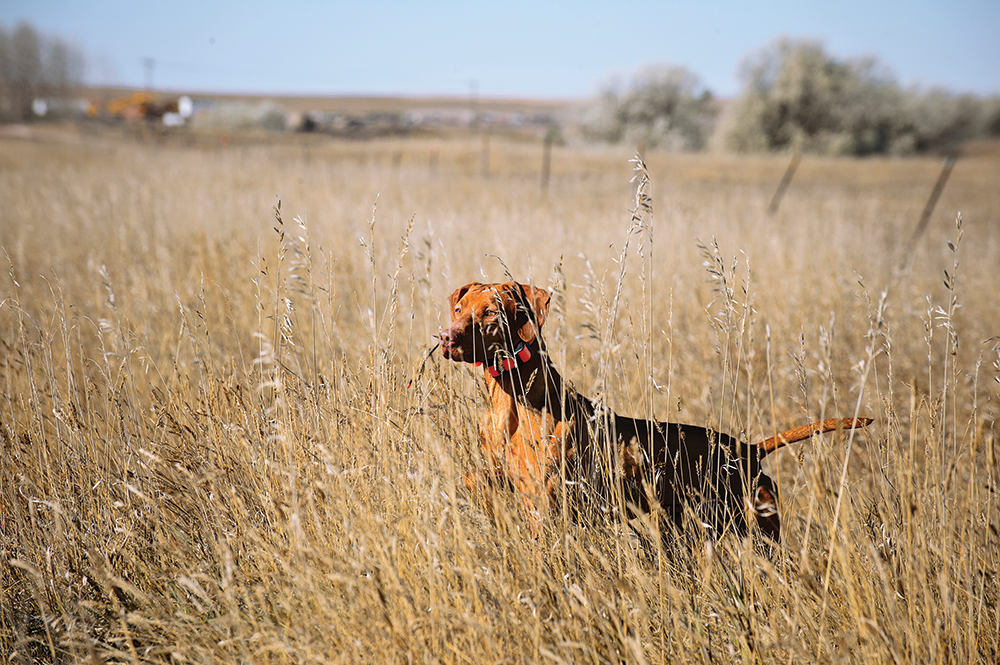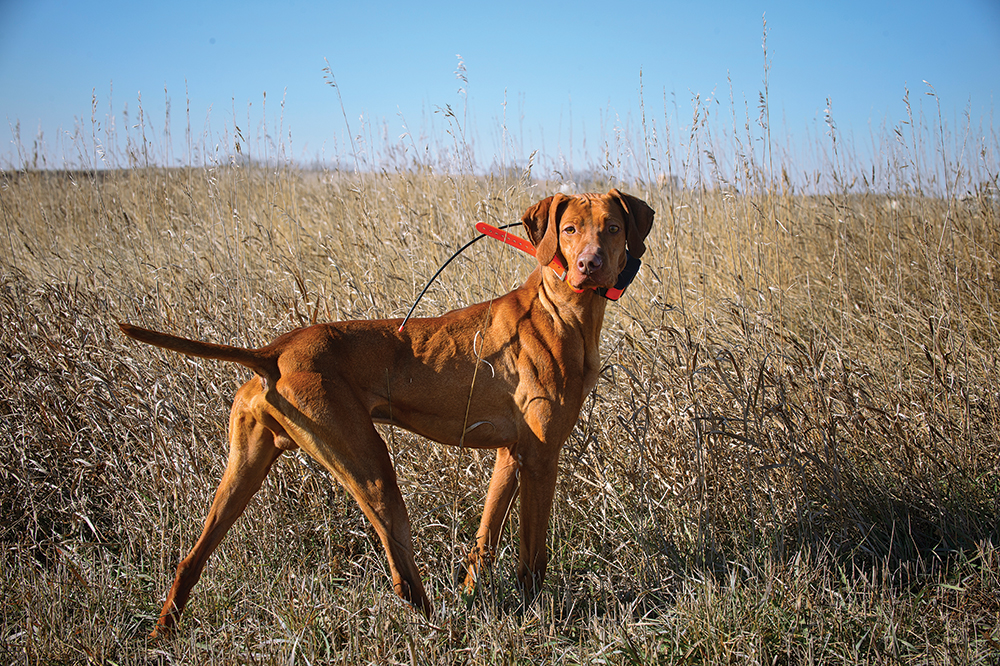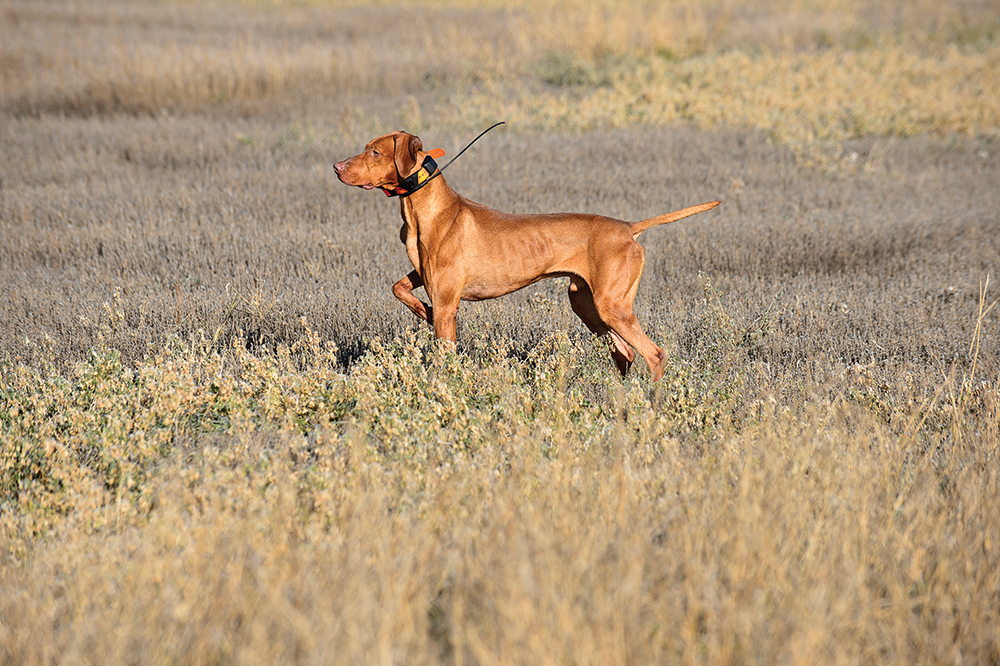Golden Points

Color first: The vizsla’s stunning coat has been compared to burnished gold and cinnamon. It’s been called tawny, russet, firelit, sunset, and spice. Forever eye-catching, the vizsla’s coat is actually a mixed blessing. While their striking color sets vizslas apart from other pointing dogs, it also makes the breed a desirable commodity for the show ring. That, in turn, means some breeders put color characteristics over nose, point, drive, and temperament—the traits hunters look for in a great field dog. Given the right balance of breeding priorities, however, vizslas can be excellent upland hunters and dedicated companions.
Sheryle and Matt Tepp of Smoothbore Vizslas in Stevens Point, Wisconsin, have been hunting with their vizslas for more than 12 years. Their objective is to “build” solid hunting dogs with good minds, physically capable of handling the demands of water work as well as field work. Baron (officially “Versatile Champion Baron’s Raising Havoc From Comynara”) proved at a young age that building on the right genetic foundation works.
When Baron was 9 months old, taken on his first hunting trip to Saskatchewan, Sheryle and Matt led Baron through a cover they call the Horseshoe Coulee, a section too sloped for farming but dense with native prairie vegetation like buffalo berry and cactus. One bird short of a full limit of sharptails and Hungarian partridge—each pointed and held by the young vizsla—Sheryle knocked a sharptail down into a tangle of thick, thorny brush. Despite his regal appearance, Baron tore in with the work ethic of a dedicated farm hand. Minutes passed, no bird. More minutes, still no bird. Then, no Baron. Assuming he’d gotten bored or quit, Sheryle starting beating the brush herself, hoping to find or flush the downed grouse.
Suddenly, a flicker of auburn a long way off caught her eye. Two coulees over, Baron appeared, galloping toward her, topping the rise twice, with the sharptail held high. “I’d clearly broken a wing and the bird was still alive,” Sheryle recalls. “Baron must have caught the trail and tracked it at least a quarter of a mile. He thought he was pretty cool, and I just about sat down and cried, he was so good.”

Vizslas vary in hunting style, with most holding to a close or medium range. Those bred from field-trial lines tend to work farther out and faster. Their point develops early and they are natural retrievers, although cold-weather water work is not their strong suit. They have a reputation for being somewhat soft, but a vizsla’s temperament would be more accurately characterized as people-oriented and biddable. Whether it’s swimming patiently downriver next to a kayak or curled up on the front seat of a truck heading into the field, vizslas want to be close to their owners. They want to please, and they make outstanding family dogs as long as they get the exercise they need to work off their energy.
“You need to give a vizsla a job or you will have a problem,” Sheryle explains. “If I don’t give Baron or the other dogs an outlet, they become very needy. It’s all about exercise, discipline, and affection.”
The history of the vizsla breed overflows with unsubstantiated accounts of origins more than a thousand years ago. What is generally regarded as true is that the Magyar people of the region now known as Hungary did use dogs for hunting. The name “vizsla” itself was originally a more generic term such as “Braque” or “Griffon.” Around 1800, the modern Hungarian vizsla was developed, but the population subsequently declined to the point where it almost disappeared.
Through the political and territorial conflicts that transferred sections of Hungary to Czechoslovakia, Romania, and Yugoslavia, the vizsla lines were reduced to those inside the Hungary’s borders. This ultimately caused a nationalist resurgence of interest in the breed, and the Hungarian Vizsla Club was established in 1920.

Following another decline through the years of World War I and World War II, the breed resurfaced with the new Hungarian Kennel Club in 1956. Today, the parent club in Hungary is the Magyar Vizsla Klub, with satellite breed clubs in the United States and several other countries. The vizsla was the 115th breed to be recognized by the American Kennel Club and is eligible for registry and testing with the North American Versatile Hunting Dog Association.
The hunting vizsla today is an elegant dog, with fluid and agile in movements. A vizsla’s smooth, flat coat seems to have been designed to show off their musculature. Males average 22 to 24 inches in height; females average 21 to 23 inches, with a weight range of 45 to 65 pounds. They can have white on the front of their chest or on their toes but nowhere else. Lighter hair on the neck and shoulders is permissible by breed standards, but no dark shadings or pale yellows are permitted.
The vizsla’s eyes, eyelids, lips, nose, toenails, and pads should all blend in color with the coat. That uniformity of color—such a remarkable color—clearly adds to the distinctive look of the breed.

“When Baron goes on point, I stop breathing,” Sheryle says. “He is so intense it seems like his toenails are vibrating.” She adds that not every Vizsla is like that; they do run the gamut in style. But those bred for mental stability and drive are creating hunting lines with the confidence to expand 300 yards on an open prairie or track a running grouse in the dense Wisconsin woods.
Because the vizsla gene pool is still relatively small and because many are being bred for the show ring, hunters looking for a vizsla puppy need to do their research. There is a surprising variation in temperament (softness), working range and style, depending on the breeder’s priorities. Dogs bred for the ring, or for field trials or agility work, might not be the best choice for the upland foot hunter. Finding out if the breeders hunt, if their dogs come from hunting lines and if they sell their dogs primarily to hunting homes, is essential. With that information, bird-dog owners may marvel at the coat and admire the elegance, but will know that a place in the household and a dedication to the hunt nurture the vizsla soul.

A vizsla is the color of a glowing sunset with the spirit of a golden, sunny day.
























